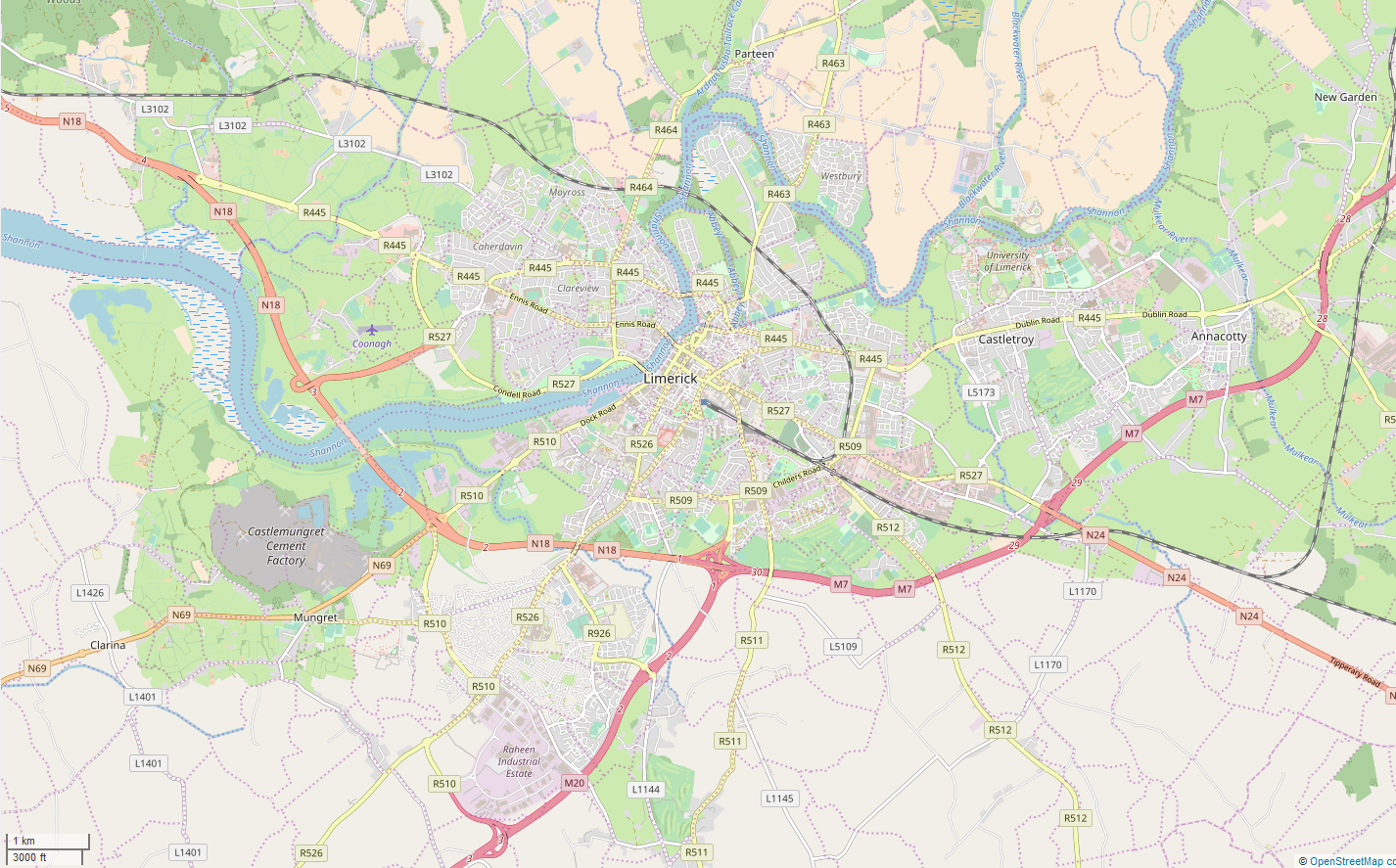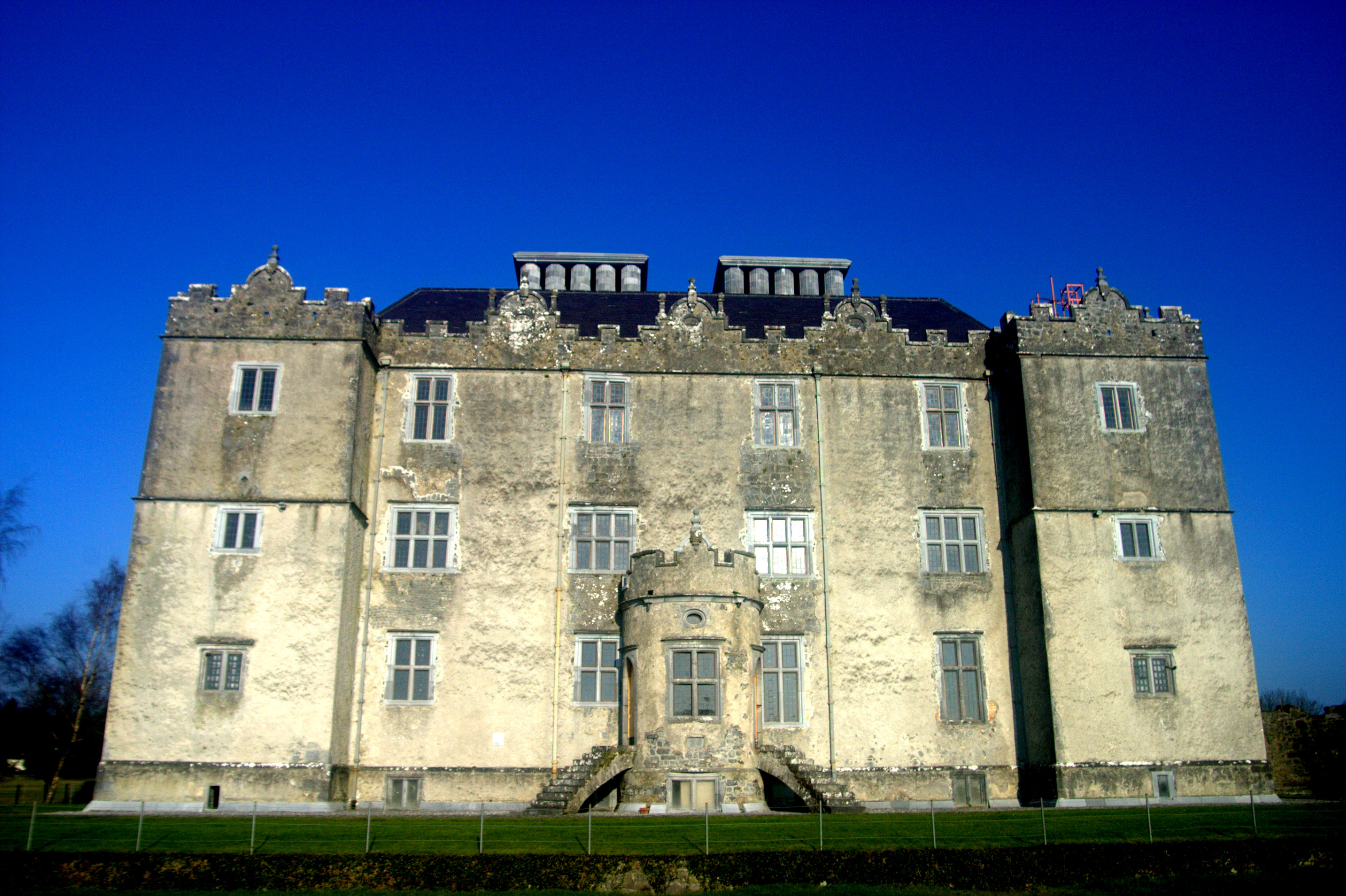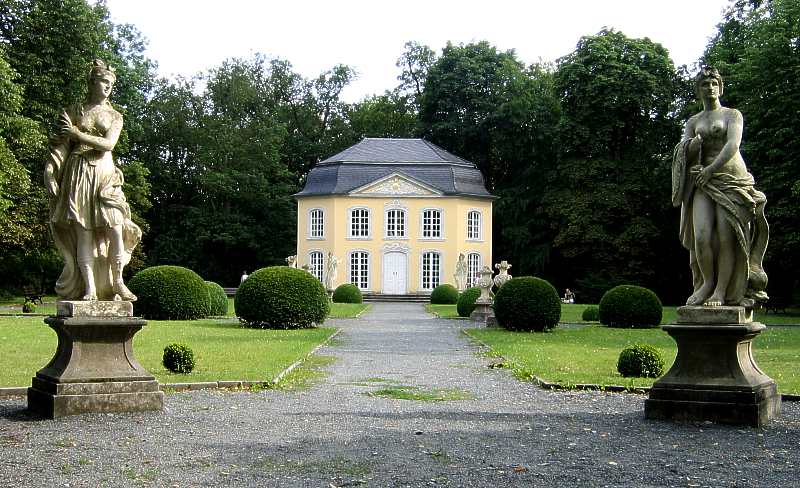|
City Hall, Limerick
City Hall () is a municipal facility at Merchant's Quay, Limerick, Ireland. It is the administrative centre of Limerick City and County Council. History City Hall was commissioned to replace the Commercial Buildings in Patrick Street which dated from 1805 and had served as the town hall from 1847. In the mid-1980s, the council leaders at Limerick Corporation decided that the council needed larger premises; the site they selected at Merchant's Quay had been occupied by an old gaol which dated from 1789. The complex had ceased to be used for custodial purposes in the 19th century and had served as Geary's Biscuit Factory since the 1920s. Most of the old buildings were demolished in 1988, although the surviving façade of the old gaol, designed by John Nash, was retained as part of the new development. The new building was designed by the Dublin-based firm, Burke-Kennedy Doyle, in the Modern style, built in stone blocks and was completed in 1990. The design involved an asymmetric ... [...More Info...] [...Related Items...] OR: [Wikipedia] [Google] [Baidu] |
Limerick
Limerick ( ; ga, Luimneach ) is a western city in Ireland situated within County Limerick. It is in the province of Munster and is located in the Mid-West which comprises part of the Southern Region. With a population of 94,192 at the 2016 census, Limerick is the third-most populous urban area in the state, and the fourth-most populous city on the island of Ireland at the 2011 census. The city lies on the River Shannon, with the historic core of the city located on King's Island, which is bounded by the Shannon and Abbey Rivers. Limerick is also located at the head of the Shannon Estuary, where the river widens before it flows into the Atlantic Ocean. Limerick City and County Council is the local authority for the city. Geography and political subdivisions At the 2016 census, the Metropolitan District of Limerick had a population of 104,952. On 1 June 2014 following the merger of Limerick City and County Council, a new Metropolitan District of Limerick was formed wit ... [...More Info...] [...Related Items...] OR: [Wikipedia] [Google] [Baidu] |
Flight Of The Wild Geese
The Flight of the Wild Geese was the departure of an Irish Jacobite army under the command of Patrick Sarsfield from Ireland to France, as agreed in the Treaty of Limerick on 3 October 1691, following the end of the Williamite War in Ireland. More broadly, the term Wild Geese is used in Irish history to refer to Irish soldiers who left to serve in continental European armies in the 16th, 17th and 18th centuries. An earlier exodus in 1690, during the same war, had formed the French Irish Brigade, who are sometimes misdescribed as Wild Geese. By country Spanish service The first Irish troops to serve as a unit for a continental power formed an Irish regiment in the Spanish Army of Flanders in the Eighty Years' War in the 1590s. The regiment had been raised by an English Catholic, William Stanley, in Ireland from native Irish soldiers and mercenaries, whom the English authorities wanted out of the country. (See also Tudor conquest of Ireland). Stanley was given a commission ... [...More Info...] [...Related Items...] OR: [Wikipedia] [Google] [Baidu] |
City And Town Halls In The Republic Of Ireland
A city is a human settlement of notable size.Goodall, B. (1987) ''The Penguin Dictionary of Human Geography''. London: Penguin.Kuper, A. and Kuper, J., eds (1996) ''The Social Science Encyclopedia''. 2nd edition. London: Routledge. It can be defined as a permanent and densely settled place with administratively defined boundaries whose members work primarily on non-agricultural tasks. Cities generally have extensive systems for housing, transportation, sanitation, utilities, land use, production of goods, and communication. Their density facilitates interaction between people, government organisations and businesses, sometimes benefiting different parties in the process, such as improving efficiency of goods and service distribution. Historically, city-dwellers have been a small proportion of humanity overall, but following two centuries of unprecedented and rapid urbanization, more than half of the world population now lives in cities, which has had profound consequences for g ... [...More Info...] [...Related Items...] OR: [Wikipedia] [Google] [Baidu] |
Buildings And Structures In Limerick (city)
A building, or edifice, is an enclosed structure with a roof and walls standing more or less permanently in one place, such as a house or factory (although there's also portable buildings). Buildings come in a variety of sizes, shapes, and functions, and have been adapted throughout history for a wide number of factors, from building materials available, to weather conditions, land prices, ground conditions, specific uses, prestige, and aesthetic reasons. To better understand the term ''building'' compare the list of nonbuilding structures. Buildings serve several societal needs – primarily as shelter from weather, security, living space, privacy, to store belongings, and to comfortably live and work. A building as a shelter represents a physical division of the human habitat (a place of comfort and safety) and the ''outside'' (a place that at times may be harsh and harmful). Ever since the first cave paintings, buildings have also become objects or canvasses of much artist ... [...More Info...] [...Related Items...] OR: [Wikipedia] [Google] [Baidu] |
Dolores O'Riordan
Dolores Mary Eileen O'Riordan ( ; 6 September 1971 – 15 January 2018) was an Irish musician, singer and songwriter. She was best known as the lead vocalist and lyricist for the alternative rock band the Cranberries. One of the most recognizable voices in rock in the 1990s, she was known for her lilting mezzo-soprano voice, signature yodel, emphasized use of keening, and strong Limerick accent. O'Riordan was born in County Limerick, Ireland, to a Catholic working-class family. She began to perform as a soloist in her church choir before leaving secondary school to join the Cranberries in 1990. Recognised for her "unique" voice, she quickly achieved worldwide fame. During her lifetime, she released seven studio albums with the Cranberries, including four number-one albums. Over the years, she contributed to the release of '' Everybody Else Is Doing It, So Why Can't We?'' (1993), '' No Need to Argue'' (1994), '' To the Faithful Departed'' (1996), '' Bury the Hatchet'' (1999) ... [...More Info...] [...Related Items...] OR: [Wikipedia] [Google] [Baidu] |
Patrick Sarsfield, 1st Earl Of Lucan
Patrick Sarsfield, 1st Earl of Lucan, ga, Pádraig Sáirseál, circa 1655 to 21 August 1693, was an Irish soldier, and leading figure in the Jacobite army during the 1689 to 1691 Williamite War in Ireland. Born into a wealthy Catholic family, Sarsfield joined a regiment recruited by James Scott, Duke of Monmouth for the 1672 to 1674 Third Anglo-Dutch War, a subsidiary of the Franco-Dutch War. After England made peace, his regiment served in the French Rhineland campaign, and when the war ended in 1678, he returned to England. Following the so-called Popish Plot, Catholics were barred from the English military, and for the next few years Sarsfield led a precarious life on the fringes of London society. When the Catholic James II came to the throne in 1685, Sarsfield served as a volunteer during Monmouth's Rebellion, and was commissioned into the Royal Army. A colonel by the time of the Glorious Revolution in November 1688, he remained loyal to James and followed him into ... [...More Info...] [...Related Items...] OR: [Wikipedia] [Google] [Baidu] |
Jacobitism
, war = , image = Prince James Francis Edward Stuart by Louis Gabriel Blanchet.jpg , image_size = 150px , caption = James Francis Edward Stuart, Jacobite claimant between 1701 and 1766 , active = 1688–1780s , ideology = * Legitimist support for the senior line of the Stuarts * Indefeasible dynastic right * Divine right of kings * Irish nationalism * Scottish nationalism , leaders = , leader1_title = Military leaders , leader1_name = , headquarters = , area = British Isles , size = , allies = *Papal States (Until 1788) , opponents = Jacobitism (; gd, Seumasachas, ; ga, Seacaibíteachas, ) was a political movement that supported the restoration of the senior line of the House of Stuart to the British throne. The name derives from the first name of James II and VII, which in Latin translates as ''Jacobus''. When James went into exile ... [...More Info...] [...Related Items...] OR: [Wikipedia] [Google] [Baidu] |
Siege Of Limerick (1691)
The siege of Limerick in western Ireland was a second siege of the town during the Williamite War in Ireland (1689–1691). The city, held by Jacobite forces, was able to beat off a Williamite assault in 1690. However, after a second siege in August–October 1691, it surrendered on favourable terms. Siege By the time of the second siege, the military situation had turned against the Jacobites; their main force had been badly defeated at the Battle of Aughrim in July, with over 4,000 killed, including their commander, the Marquis de St Ruth, and thousands more either taken prisoner or deserted. The town of Galway capitulated in July 1691; its Jacobite garrison was accorded 'all the honours of war,' which allowed them to retain their weapons and receive a free pass to Limerick. However, although its defences had been considerably strengthened since 1690, morale was now much lower after a series of defeats and retreats. By now, siege warfare was an exact art, the rules of whic ... [...More Info...] [...Related Items...] OR: [Wikipedia] [Google] [Baidu] |
Spokane, Washington
Spokane ( ) is the largest city and county seat of Spokane County, Washington, United States. It is in eastern Washington, along the Spokane River, adjacent to the Selkirk Mountains, and west of the Rocky Mountain foothills, south of the Canadian border, west of the Washington–Idaho border, and east of Seattle, along I-90. Spokane is the economic and cultural center of the Spokane metropolitan area, the Spokane–Coeur d'Alene combined statistical area, and the Inland Northwest. It is known as the birthplace of Father's Day, and locally by the nickname of "Lilac City". Officially, Spokane goes by the nickname of ''Hooptown USA'', due to Spokane annually hosting Spokane Hoopfest, the world's largest basketball tournament. The city and the wider Inland Northwest area are served by Spokane International Airport, west of Downtown Spokane. According to the 2010 census, Spokane had a population of 208,916, making it the second-largest city in Washington, and the 1 ... [...More Info...] [...Related Items...] OR: [Wikipedia] [Google] [Baidu] |
Republic Of Ireland
Ireland ( ga, Éire ), also known as the Republic of Ireland (), is a country in north-western Europe consisting of 26 of the 32 Counties of Ireland, counties of the island of Ireland. The capital and largest city is Dublin, on the eastern side of the island. Around 2.1 million of the country's population of 5.13 million people resides in the Greater Dublin Area. The sovereign state shares its only land border with Northern Ireland, which is Countries of the United Kingdom, part of the United Kingdom. It is otherwise surrounded by the Atlantic Ocean, with the Celtic Sea to the south, St George's Channel to the south-east, and the Irish Sea to the east. It is a Unitary state, unitary, parliamentary republic. The legislature, the , consists of a lower house, ; an upper house, ; and an elected President of Ireland, President () who serves as the largely ceremonial head of state, but with some important powers and duties. The head of government is the (Prime Minister, liter ... [...More Info...] [...Related Items...] OR: [Wikipedia] [Google] [Baidu] |
Pavilion
In architecture, ''pavilion'' has several meanings: * It may be a subsidiary building that is either positioned separately or as an attachment to a main building. Often it is associated with pleasure. In palaces and traditional mansions of Asia, there may be pavilions that are either freestanding or connected by covered walkways, as in the Forbidden City ( Chinese pavilions), Topkapi Palace in Istanbul, and in Mughal buildings like the Red Fort. * As part of a large palace, pavilions may be symmetrically placed building ''blocks'' that flank (appear to join) a main building block or the outer ends of wings extending from both sides of a central building block, the '' corps de logis''. Such configurations provide an emphatic visual termination to the composition of a large building, akin to bookends. The word is from French (Old French ) and it meant a small palace, from Latin (accusative of ). In Late Latin and Old French, it meant both ‘butterfly’ and ‘tent’, becaus ... [...More Info...] [...Related Items...] OR: [Wikipedia] [Google] [Baidu] |
River Shannon
The River Shannon ( ga, Abhainn na Sionainne, ', '), at in length, is the longest river in the British Isles. It drains the Shannon River Basin, which has an area of , – approximately one fifth of the area of the island of Ireland. The Shannon divides the west of Ireland (principally the province of Connacht) from the east and south ( Leinster and most of Munster). (County Clare, being west of the Shannon but part of the province of Munster, is the major exception.) The river represents a major physical barrier between east and west, with fewer than thirty-five crossing points between Limerick city in the south and the village of Dowra in the north. The river takes its name after ''Sionna'', a Celtic goddess. Known as an important waterway since antiquity, the Shannon first appeared in maps by the Graeco-Egyptian geographer Ptolemy ( 100 – 170 AD). The river flows generally southwards from the Shannon Pot in County Cavan before turning west and emptying int ... [...More Info...] [...Related Items...] OR: [Wikipedia] [Google] [Baidu] |









.jpg)